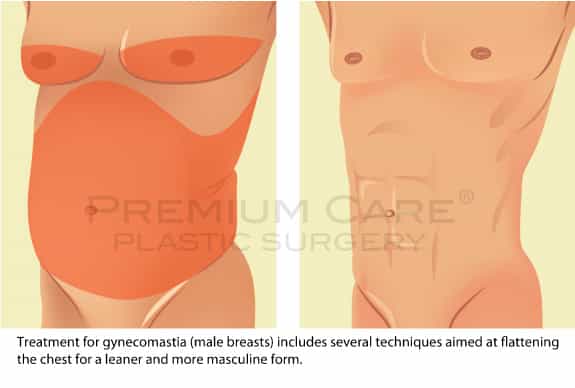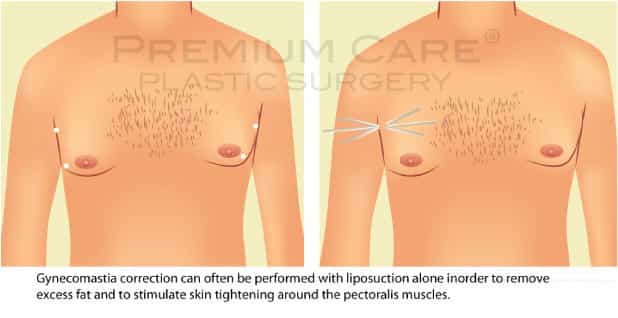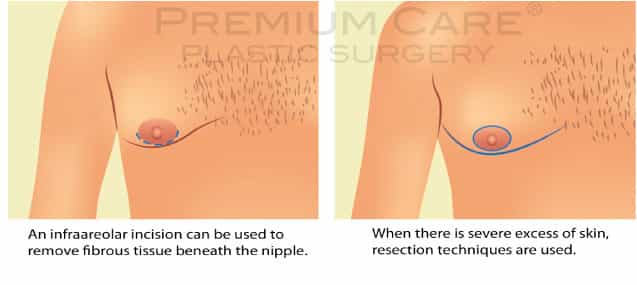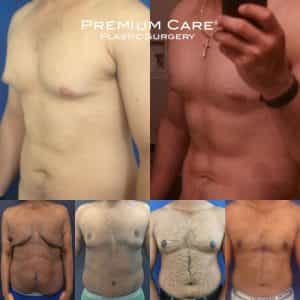Male Breast Reduction in Colombia at Premium Care Plastic Surgery
What is Male Breast Reduction?
Male breast reduction surgery, also known as gynecomastia correction, is a procedure that removes excess fat, glandular tissue, and/or skin from the chest to create a flatter, firmer, and more masculine chest contour.
Why choose Premium Care Plastic Surgery in Colombia?
🌍 Trusted by International Patients
1. Top-Tier Surgeons and Expertise
2. State-of-the-Art Facilities
3. Comprehensive, Personalized Care and Cost Savings Without Compromising Quality
CONTACT US
Restore Confidence and Masculine Contour with Gynecomastia Surgery in Cartagena
At Premium Care Plastic Surgery in Cartagena, Colombia, our board-certified plastic surgeons specialize in treating men with true gynecomastia (excess gland tissue) or pseudogynecomastia (excess fat), delivering natural-looking, long-lasting results through customized surgical techniques.
Whether caused by hormonal changes, weight gain, genetics, or past medication use, gynecomastia can be distressing and difficult to resolve with diet or exercise alone. Surgery offers a permanent and effective solution—in a safe, discreet, and supportive environment.
The embarrassment men feel from this extremely common condition can have a negative effect on their lives. Many will avoid removing their shirts at the beach or wear layers of clothes to hide their bodies. Fortunately male breast reduction Colombia is a simple, effective way to attain a more masculine-looking chest.

Who Is a Candidate for Male Breast Reduction?
You may be a candidate if you:
✔ Have enlarged or puffy male breasts that affect confidence or daily life
✔ Feel self-conscious wearing fitted shirts or going shirtless
✔ Have tried to improve the condition through diet and exercise with limited success
✔ Are in good general health and at a stable weight
✔ Desire permanent, visible improvement in chest contour
What Does the Procedure Involve?
Surgical correction is tailored based on the underlying cause and severity of gynecomastia. The procedure typically involves one or more of the following techniques:
🔹 Liposuction
Used when the excess tissue is mostly fatty. Tiny incisions are made, and excess fat is removed with a fine cannula to sculpt the chest.
🔹 Glandular Excision
When dense glandular tissue is present behind the nipple, a small incision around the areola allows direct removal for a flatter contour.
🔹 Skin Excision
In more advanced cases or after massive weight loss, excess skin may also be removed to tighten and lift the chest.
Surgery is performed under general anesthesia, depending on the case. It typically takes 1.5 to 2.5 hours and is done in our accredited surgical center.


Recovery & Aftercare
Recovery is generally quick and manageable, especially in our luxury recovery environment. Most men return to daily activity within one week.
🗓️ Recovery Timeline:
Days 1–3: Rest with light activity; compression garment worn to reduce swelling
Day 3–7: Walking and mobility encouraged; minimal discomfort
Week 2: Return to light work or remote activity
Week 4–6: Resume gym and exercise
Month 3: Final chest contour visible as swelling subsides and tissue settles
You’ll wear a custom compression vest for 3–4 weeks to support healing and improve results.
How Long Should I Stay in Cartagena?
We recommend that international patients plan to stay in Cartagena for 7 to 10 days
People Love Us
Male Breast Reduction Colombia Videos
Male Breast Reduction before and after

Looking for more information about Male Breast Reduction in Colombia?
About Male Breast Reduction Colombia
Gynecomastia, a condition of over-developed or enlarged breasts in men, is common in men of any age and affects as many as 30% of men. It can be the result of hormonal changes, heredity conditions, disease or the use of certain drugs. Enlarged breasts can be permanent, uncomfortable, and socially and psychologically devastating, but they can be permanently removed through plastic surgery. Some men may even avoid certain physical activities and intimacy simply to hide their condition.
GYNECOMASTIA IS CHARACTERIZED BY:
- Excess localized fat
- Excess glandular tissue development
- A combination of both excess fat and glandular tissue
- Gynecomastia may be present unilaterally (one breast) or bilaterally (both breasts)
Gynecomastia may be associated with obesity, hormonal metabolism imbalance, liver disease, or medicinal causes. Prior to choosing a surgical solution to gynecomastia, a period of diet and exercise is recommended to see if your condition can be resolved naturally. Should that fail, our plastic surgeons in Colombia will recommend surgical intervention – Male breast reduction Colombia.
Consultation & Preparation
YOUR CONSULTATION AT PREMIUM CARE PLASTIC SURGERY
During your consultation, we’ll help you to feel comfortable explaining your goals and expectations, and your surgeon will assess your existing anatomy to determine the cause of your breast enlargement. Male breasts may be formed from fatty tissue and/or glandular tissue. If male breast reduction surgery is right for you, it will be performed on an outpatient basis with anesthesia. The procedure can last from 1 to 3 hours depending on the extent of correction.
Be prepared to discuss:
- Why you want the surgery, your expectations and desired outcome
- Your general health status and any pre-existing health conditions or risk factors
- Medical conditions, drug allergies and medical treatments
- Previous surgeries
- Use of current medications, vitamins, herbal supplements, alcohol, and tobacco
After we gain an understanding of what the patient wants, we then proceed to the examination. We consider many features including breast volume, width, composition (fat versus fibrous tissue), nipple position, areola size, and skin tone. Chests are highly variable, and we help the patient understand what their best options are based on their physical characteristics.
YOUR PLASTIC SURGEON AT PREMIUM CARE WILL ALSO:
- Take photographs for your medical record
- Discuss your options and recommend a course of treatment
- Discuss likely outcomes of surgery and any risks or potential complications
IS IT RIGHT FOR ME?
Gynecomastia surgery is a highly individualized procedure and you should do it for yourself, not to fulfill someone else’s desires or to try to fit any sort of ideal image.
THIS PROCEDURE IS A GOOD OPTION FOR YOU IF:
- You are physically healthy and of relatively normal weight
- You have realistic expectations
- Your breast development has stabilized
- You are bothered by the feeling that your breasts are too large
Adolescents may benefit from surgery, although secondary procedures may be needed in the future should breast development continue.
Male breast reduction Colombia – CORRECTION OF GYNECOMASTIA IS BEST PERFORMED ON:
- Men whose condition cannot be corrected through alternative medical treatments
- Healthy individuals who do not have a life-threatening illness or medical conditions that can impair healing
- Non-smokers and non-drug users
- Men with a positive outlook and specific goals in mind for improving the physical symptoms of gynecomastia
PREPARING FOR YOUR MALE BREAST REDUCTION COLOMBIA
Premium Care Plastic Surgery encourages you to take a few simple steps in preparation for your procedure. Following the steps presented below will make your recovery from surgery as safe, short and relaxing as possible.
Your surgeon will provide you with a list of specific steps you should take leading up to your procedure. This list might include limiting your use of certain medications, alcohol and cigarettes, and minor changes in your grooming habits. These changes are temporary but very important to your comfort and safety.
BEFORE MALE BREAST REDUCTION COLOMBIA, YOU MAY BE ASKED TO:
- Get lab testing or a medical evaluation
- Take certain medications or adjust your current medications
- Stop smoking well in advance of surgery
- Avoid taking aspirin, anti-inflammatory drugs and herbal supplements as they can increase bleeding
SPECIAL INSTRUCTIONS YOU RECEIVE WILL COVER:
- What to do on the day of surgery
- The use of anesthesia during your surgery
- Post-operative care and follow-up
- Medications to purchase and bring with you on the day of surgery.
Smoking increases the risks of many potential complications of surgery and should be avoided. Patients who smoke should stop at least two weeks before surgery, but even then they are still at increased risk when compared to non-smokers. Nicotine patches or gum are also associated with increased complications and should not be used in preparation for surgery.
On the day of your surgery, we ask that you wear no jewelry or make-up and avoid deodorant, skin lotions and perfume. We recommend warm, loose fitting clothing, such as pajamas or sweat pants with thick socks or slippers to prevent the chills commonly experienced after surgery. Please inform your surgeon if you have a cold, sore throat, active allergies or an open cut or sore on the day of your surgery.
You’ll need help. Arrange for someone to drive you to and from surgery and to stay with you for at least the first night following surgery. Effective planning prior to undergoing liposuction can make your recovery as brief and relaxing as possible.
To take the next step, arrange a personal consultation with Premium Care Plastic Surgery in Colombia by calling (+57) 312 545 5569 in Cartagena and (+1) 305 848 1909 in United States or use our convenient online form to request a consultation online. You’ll be amazed about how affordable cosmetic plastic surgery can be, and with an experience like no other!
Procedure & Recovery
SURGICAL TECHNIQUE:MALE BREAST REDUCTION (GYNECOMASTIA)
At the root of gynecomastia, or enlarged male breasts, is excess tissue and fat that can make the breasts appear larger. Male breast enlargement may be caused by loose skin, excess fat or breast tissue, or excess areolar tissue. It’s important to diagnose exactly what needs to be removed to achieve a slimmer, smoother chest. At Premium Care, we have years of experience that allows us to diagnose and treat gynecomastia with your individual anatomy and concerns in mind. We then develop a surgical plan with you to meet your goals.
STEPS OF MALE BREAST REDUCTION SURGERY
Plastic surgery to correct gynecomastia is technically called reduction mammaplasty, and reduces breast size, flattening and enhancing the chest contours.
In severe cases of gynecomastia, the weight of excess breast tissue may cause the breasts to sag and stretch the areola (the dark skin surrounding the nipple). In these cases the position and size of the areola can be surgically improved and excess skin may be reduced.
ANESTHESIA
Medications are administered for your comfort during the surgical procedure. The choices include intravenous sedation and general anesthesia. Your doctor will recommend the best choice for you.
LIPOSUCTION
In cases where gynecomastia is primarily the result of excess fatty tissue, liposuction techniques alone may be used.
This requires insertion of a cannula, a thin hollow tube, through several small incisions. The cannula is moved back and forth in a controlled motion to loosen the excess fat, which is then removed from the body by vacuum suction.
There are various liposuction techniques that may be used; the technique most appropriate in your case will be defined prior to your procedure.
EXCISION
Excision techniques are recommended where glandular breast tissue or excess skin must be removed to correct gynecomastia.
Excision also is necessary if the areola will be reduced, or the nipple repositioned to a more natural male contour. Incision patterns vary depending on the specific conditions and surgical preference.
Depending on your condition, we may recommend liposuction combined with breast tissue removal, or breast tissue removal alone. In extreme cases, such as following massive weight loss, skin removal may be necessary as well. Given all the options, it’s important to choose a surgeon who has performed many of these procedures and takes the time to examine you, understand your goals and explain your options.
We’d be happy to talk with you further about achieving a more masculine chest at Premium Care. Simply request a consultation online or call us at in Cartagena to schedule an appointment.
YOUR RECOVERY
RECOVERY FROM MALE BREAST REDUCTION SURGERY
In Colombia, male breast reduction is usually performed as an outpatient procedure. After surgery, you will wear a snug-fitting support garment, like a vest, for about a week to minimize swelling and bruising. It’s natural to experience some discomfort, but it is easily managed with mild pain medication. Most of our patients ease back into their routines within a few days. Healing continues for several weeks, and you’ll immediately see improvements in your chest contour.
The final results of breast reduction in men are permanent in many cases. However, if gynecomastia resulted from the use of certain prescription medications, drugs including steroids or weight gain you must be fully free from these substances and remain at a stable weight in order to maintain your results. Please discuss this with your physician before making changes to your prescription medications.
WILL THERE BE SCARS?
Any surgical treatment to correct gynecomastia will require incisions. While most incision lines are concealed within natural contours, some may be visible and are a necessary result of breast reduction surgery. Your improved upper body will likely enhance your self-image and confidence, whether in a shirt and tie, a t-shirt, or shirtless at the beach.
RISKS
Possible but uncommon risks include infection, bleeding and seromas (pockets of fluid). Each of these complications may be treated effectively with diligent postoperative care.
If you’re ready to meet with our plastic surgeons at Premium Care Plastic Surgery in Colombia, you can request a consultation online or contact us at (+57) 312 545 5569 in Cartagena and (+1) 305 8481909 in United States.
Vocabulalry & FAQ's
Surgical Technique: Gynecomastia: Words to Know
- Areola: Pigmented skin surrounding the nipple.
- Bilateral gynecomastia: A condition of over-developed or enlarged breasts in men affecting both breasts.
- Endocrine system: A group of glands that make hormones which help to control activities in your body such as reproduction, metabolism, growth and development. Testing of your endocrine system may be done to look for signs of diabetes, thyroid disorders, growth hormone deficiency, osteoporosis, hypertension and obesity.
- Excision: To remove the skin.
- General anesthesia: Drugs and/or gases used during an operation to relieve pain and alter consciousness.
- Hematoma: Blood pooling beneath the skin.
- Intravenous sedation: Sedatives administered by injection into a vein to help you relax.
- Liposuction: Also called lipoplasty or suction lipectomy, this procedure vacuums out fat from beneath the skin’s surface to reduce fullness.
- Local anesthesia: A drug injected directly to the site of an incision during an operation to relieve pain.
- Reduction mammaplasty: The surgical removal of breast tissue to reduce the size of breasts.
- Sutures: Stitches used by surgeons to hold skin and tissue together.
- Unilateral gynecomastia: A condition of over-developed or enlarged breasts in men affecting just one breast.
GYNECOMASTIA: FREQUENTLY ASKED QUESTIONS
Why me? Why do I have gynecomastia?
That’s a very sincere, good question. But a better question really is, “Why not me?” More men will get gynecomastia than will not, so the chances are better that you will ask yourself the question than you will not.
How do I know that I have gynecomastia and not cancer?
Male breast cancer is rare, but it does occur. Usually, it happens in men in their 60s and 70s, and often it is one-sided, starting as a firm and often painless mass. The content of this site is for information purposes only, and there is nothing that can be said to be sure that you do not have cancer. If you have a mass in your breast, you should seek medical attention.
How do I decide between several different plastic surgeons?
Remember, this is elective surgery. Do not feel rushed. If you do not feel enthusiastic about proceeding, or if you are not confident about a doctor, then just wait until everything seems right. Look at photos of their results after male chest reduction surgery. Do they seem to be experienced and knowledgeable about gynecomastia and how to correct it with surgery? Where were they trained? Do you have a choice of anesthesia? Do they have an accredited operating room? Do they seem to understand what bothers you, and do they seem capable of delivering you the result that you want? These are some of the questions that you should be considering.
Could drugs or medications cause gynecomastia?
There are some men who are on medications known to cause gynecomastia, whether by prescription or illicitly. It is advisable to curtail all illicit substances for many reasons, beyond just the gynecomastia. If you are on prescription medicines that might be related to causing gynecomastia, discuss with your prescribing doctor whether there are alternative drugs for you to take.
What’s the youngest you would operate on a patient with gynecomastia?
There is no absolute age requirement. In general, we wait until puberty has finished and the hormone levels have stabilized, which is usually 18-20 years old. However, there are cases in which the chest enlargement is so severe that it seems cruel to make a child live with it all through high school in the hopes that it will get better. I have operated on boys for gynecomastia as young as 12 – but only with a letter from their pediatrician agreeing that their problem is so severe and emotionally so difficult that he or she feels that they should not wait. Most of the time gynecomastia experienced during puberty will go away, and that is why we wait. But if it is causing enough distress, we will consider treating the gynecomastia earlier. That decision must be individualized to the age of the boy, the extent to which it is bothering him, all discussed in detail with the boy, his parents, and his pediatrician.
What is the oldest you would treat a man with male breast enlargement?
There is no age limit per se, only the general health status of the patient. But the older patients get – particularly in their 60s and 70s – but even younger sometimes – the more I worry about male breast cancer. The point of this is to say that even if a man has an enlargement of his chest and he is older and in ill health, he still must see a doctor to make sure that there is not cancer in his chest. But it is very common that men in their 60s and 70s getting facelifts may also ask about having a chest reduction. Whether from medications, obesity in the past or present, or simply gynecomastia left over from puberty that never went away, once aware that something can be done about it, many men ask for treatment of their gynecomastia.
How is gynecomastia treated?
The most common technique involves making an incision around part of the areola to cut away the thick, glandular tissue, and then to perform liposuction to thin out the chest and contour the entire area. In some cases, particularly very thin men with just a little “puffiness” under the areola, and a very firm, well-delineated mass, excision alone is all that is needed. But when the chest is diffusely enlarged and is very soft and spongy – usually in men that are or have been a bit overweight – liposuction alone can give an excellent result. But sometimes a patient feels on initial exam like they just have fat. But during the operation, after the removal of the fat, the glandular tissue can suddenly be felt – just as if you might imagine the chocolate melting in a candy bar, and an almond embedded in the center gradually becomes increasingly obvious. There is no right or wrong approach; the patient and I decide beforehand what the goal is. If it is to make them as flat as possible, then we usually proceed with doing both. If the patient is overweight, there is obviously a lot of fat, the patient does not expect to be totally flat, and doesn’t want the scar around part of the areola, then we may not do an excision. Each case is individualized, but to repeat, most of the time there needs to be both liposuction and excision.
Do people ever need gynecomastia surgery done more than once?
While a single surgery usually corrects gynecomastia for life, there are times in which patients come back for another surgery. The most common situation is when liposuction alone was done, and residual glandular tissue needs to be removed later. These men will often have noticed a big improvement in their male chest enlargement following the first procedure, but with the fat melted away, a firm bulge might be seen and felt beneath the areola, and they simply want to be flatter. In other cases, there can be an asymmetry – more fat was removed on one side than the other, or for some reason the contour is not ideal or symmetrical. Finally, men with very glandular types of gynecomastia, particularly ones that might be related to medications, marijuana, or steroid use, may return after future use of those substances.
What’s the scarring like after surgery for treating male breasts?
The scarring depends upon what needs to be done: liposuction, excision, or both. If it is liposuction alone, there is usually a ¼” scar along the border of the areola. Through that, we suck fat out of that breast and from the opposite breast. Usually, however, it is necessary to make one other incision if the surgeon removes glandular tissue. This technique requires that a small peri-areolar incision, or a half-circle incision around the lower half of the areola, be made. In most cases the surgeon will also perform liposuction to sculpt the chest into the best contour/shape possible. Whichever technique your surgeon uses, there will be scarring afterward. However within 6 months to a year most scars fade to the point where you cannot distinguish them from your normal skin.
My gynecomastia is pretty bad: it almost looks like I have female breasts. What do you do for that?
In almost all situations, it is also treated with removal of the gland through an incision around the areola and with liposuction. Even with fairly extreme cases of gynecomastia, the skin shows a powerful ability to contract. But there are some extraordinary cases in which skin does need to be removed – essentially doing a breast lift. When a patient has a lot of laxity and we are concerned that this is a possibility, we will discuss it ahead of time. But because the extent of skin contraction is so great, we typically do not do a skin excision at the same time as the removal of the gynecomastia. We will do an excision of the gynecomastia with liposuction, place a drain, have the patient wear good compression, and then come back and reassess, only doing the lift later, which is rarely necessary. Breast lift scars on a man can be very unsightly, and are often more cosmetically debilitating than a bit of skin laxity, so we try to avoid breast lift scars on a man at all costs.
What is the surgical goal in treating male breast enlargement?
The objective in the surgical treatment of gynecomastia is to make the chest proportional to the rest of the torso. If a man is significantly overweight, it would look odd to make the chest totally flat; if a man is very thin, then the chest should be quite flat. With less fat over the pectoralis muscle, treatment of gynecomastia should make it so that the pectoralis muscles are easier seen after surgery. Your efforts in the gym will now show through without gynecomastia hiding the shape of your muscles.
Can I have chest reduction surgery if I am overweight?
While it is better to do plastic surgery when someone is at their ideal weight, true gynecomastia does not fluctuate much with weight. The rubbery, glandular tissue of true gynecomastia is gland tissue. It can be affected by hormones and drugs, but is not affected much by body weight. Body weight just affects fat. So if there is a lot of fat in your chest, then weight fluctuations can affect the chest. The question to ask yourself is this: is your chest out of proportion to the rest of your body? If it is, then you at least should consider speaking to a plastic surgeon.
What do I need to do to prepare for having correction of gynecomastia?
Every plastic surgeon has a different routine they want patients to follow before gynecomastia surgery. Usually, patients are asked to quit smoking and stop all aspirin containing products. In addition, herbal remedies that can thin the blood or increase anesthetic risks are terminated. Your surgeon will give you a specific list that they want you to follow.
How long is recovery after gynecomastia surgery?
Most patients take 3-4 days off work, but some go back a day or two later. For the first 48 hours after surgery, you will have a tight surgical vest over your chest, with foam padding underneath it. This stays in place for the first 48 hours. After that, the vest is removed and cleaned, and the foam is thrown away. There is no absolute rule on how much and for how long the vest must be worn, but it is clear that men who use the compression more definitely get better faster. The vest is bulky for some men, so a lot of guys get one of those tight lycra/spandex undershirts to wear under their clothing. We ask gynecomastia patients to wear compression for as much as they can tolerate for about the first month after surgery, but this varies according to their particular case. Stitches around the areola are dissolvable, and liposuction sutures are removed about 4-5 days after surgery.
Do I have to stay in the hospital after gynecomastia surgery?
Gynecomastia surgery is done as an outpatient. You need to have someone drive you home and stay with you the first day, but you do not need to stay in the hospital. Out of town patients can stay at one of our partner hotels nearby.
How much pain is there after surgery for male breast enlargement?
Most patients say that they feel sore after gynecomastia surgery, akin to working out too hard or the day after getting punched hard in the chest. It is very uncommon for a patient to actually say that it was painful. A long acting pain medication is injected during the procedure, and that reduces pain quite substantially for the first 24 hours. You are also given plenty of pain medicine, and it works very quickly at eliminating any pain.
Will I have drains after gynecomastia surgery?
Some surgeons drain all the time; some none of the time. We usually do not put in drains unless there is a substantial amount of tissue removed and the skin is loose. The drain helps empty the fluid out of the space so that it can flatten out and heal. When we do use a drain, it is usually for just for a couple of days.
Do I have to wear a surgical vest after gynecomastia surgery?
Although not absolutely essential, it appears that keeping good compression on the chest after male breast reduction surgery helps the swelling and bruising to go away faster. Whether the final result is any different – or you just get there quicker – is not entirely clear, because it is so hard to judge. But I encourage patients to have some form of compression over their chest for about 4-6 weeks after surgery. If you do not want to wear the surgical vest we give you, it can also be helpful to wear a tight, lycra/spandex type of an undershirt.
We’d be happy to talk with you further in Cartagena about achieving a more masculine chest at Premium Care Plastic Surgery in Colombia. Simply request a consultation online or call us at (+57) 312 545 5569 in Cartagena and (+1) 305 8481909 in United States to schedule an appointment.
📞 Ready to Feel Comfortable in Your Own Skin?
Premium Care Plastic Surgery – Your Destination for Gynecomastia Correction in Colombia
Regain your confidence, sculpt your chest, and recover in a private, tropical setting—guided by expert hands every step of the way.
📞 Call (USA): +1 305 848 1909
💬 WhatsApp (Colombia): +57 312 545 5569
📩 Schedule Your Free Virtual Consultation Today
📸 Follow Results on Instagram: @premiumcareps
📺 Watch Real Patient Stories on YouTube: Premium Care Plastic Surgery Channel



